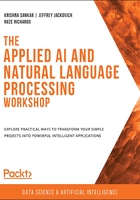
How Is AWS Special?
Today, there are many cloud providers, with the market share breakdown as follows: as per the Canalys analysis (https://www.canalys.com/static/press_release/2020/Canalys---Cloud-market-share-Q4-2019-and-full-year-2019.pdf), as of Q4 2019, AWS is the top vendor, owning nearly a third of the overall public cloud infrastructure market (32%), leading by a wide margin over Microsoft (18%), Google (6%), and Alibaba (5%).
These numbers vary depending on the source, and they may change in the future, but all agree that Amazon is the largest provider at the moment. One of the reasons for this is that Amazon offers a very large array of cloud services. In fact, one of their competitive advantages is exactly that: a very broad and deep cloud computing ecosystem. For example, in the area of ML, Amazon has thousands of use cases, with the professed goal of every imaginable ML service being provided on AWS. This explains our focus on doing ML on AWS.
What Is ML?
ML and AI go hand in hand. ML is the art and science of predicting real-world outcomes based on knowledge of the world and its history. You build a model that allows you to predict the future. The model is based on a formula or a process that formulates this prediction. The model is trained using data.
AI is a wider area of science, which includes, together with ML, all the ways of imitating human behavior and capabilities. However, the way people use these terms vary, depending on who you ask. People also tend to use the current most popular term, mostly for search engine optimization. In this book, we will take the liberty of using these two terms interchangeably.
ML is essential to learn in today's world because it is an integral part of all industries' competitive and operational data strategies. More specifically, ML allows insights from NLP to power chatbots, ML insights are used in the financial industry; and ML applications allow efficient online recommendation engines, such as friend suggestions on Facebook, Netflix displaying movies you will probably like, and more items to consider on Amazon.
What Is AI?
AI is intelligence that's demonstrated by machines. More specifically, it refers to any device that perceives its environment and takes actions that increase its chance of successfully achieving its goals. Contemporary examples are understanding human speech, competing at the highest levels of strategic games (such as Chess and Go), and autonomous cars.
AI is important because it adds intelligence to existing products. Products that are currently used will be further improved with AI capabilities; for example, Siri was added to a new generation of Apple products. Conversational chatbots can be combined with large amounts of data to improve technologies at home and in the office.
In this chapter, we will introduce you to the first few AWS services that will start you on the way to doing ML on AWS. Whenever we can, we will stick to the free tier of AWS. You get the free tier for 1 year, and it is limited in the number of computing resources you can use. Readers willing to invest a few dollars in learning with a regular AWS account will find the money well spent. Another alternative is to use packaged labs, such as Qwiklabs, which lets you do labs at will, with the added convenience of shutting the labs down so that you will not incur accidental charges when you leave your machines running.